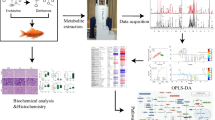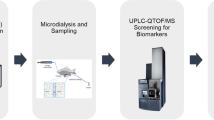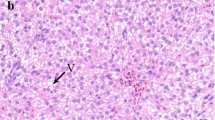Abstract
In the environment, aquatic organisms are not only directly exposed to pollutants, but the effects can be exacerbated along the food chain. In this study, we investigated the effect of the food (water flea) on the secondary consumer (zebrafish) with the exposure diclofenac (DCF) Both organisms were exposed to an environmentally relevant concentrations (15 µg/L) of diclofenac for five days, and zebrafish were fed exposed and non-exposed water fleas, respectively. Metabolites of the water fleas were directly analyzed using HRMAS NMR, and for zebrafish, polar metabolite were extracted and analyzed using liquid NMR. Metabolic profiling was performed and statistically significant metabolites which affected by DCF exposure were identified. There were more than 20 metabolites with variable importance (VIP) score greater than 1.0 in comparisons in fish groups, and identified metabolites differed depending on the effect of exposure and the effect of food. Specifically, exposure to DCF significantly increased alanine and decreased NAD + in zebrafish, which means energy demand was increased. Additionally, the effects of exposed food decreased in guanosine, a neuroprotective metabolite, which explained that the neurometabolic pathway was perturbated by the feeding of exposed food. Our results which short-term exposed primary consumers to pollutants indirectly affected the metabolism of secondary consumers suggest that the long-term exposure further study remains to be investigated.




Similar content being viewed by others
References
Nkwunonwo UC, Odika PO, Onyia NI (2020) A review of the Health Implications of Heavy Metals in Food Chain in Nigeria. Sci World J 2020:6594109. https://doi.org/10.1155/2020/6594109
Wang W, Gao H, Jin S, Li R, Na G (2019) The ecotoxicological effects of microplastics on aquatic food web, from primary producer to human: a review. Ecotoxicol Environ Saf 173:110–117. https://doi.org/10.1016/j.ecoenv.2019.01.113
Chae Y, An YJ (2016) Toxicity and transfer of polyvinylpyrrolidone-coated silver nanowires in an aquatic food chain consisting of algae, water fleas, and zebrafish. Aquat Toxicol 173:94–104. https://doi.org/10.1016/j.aquatox.2016.01.011
Tang Y, Liu Y, Chen Y, Zhang W, Zhao J, He S et al (2021) A review: Research progress on microplastic pollutants in aquatic environments. Sci Total Environ 766:142572. https://doi.org/10.1016/j.scitotenv.2020.142572
Elliott PN (2010) Non-steroidal anti-inflammatory drugs. Drugs in Sport. 317
Fatta-Kassinos D, Hapeshi E, Achilleos A, Meric S, Gros M, Petrovic M et al (2011) Existence of pharmaceutical compounds in tertiary treated urban wastewater that is utilized for reuse applications. Water Resour Manage 25:1183–1193. https://doi.org/10.1007/s11269-010-9646-4
Fent K, Weston AA, Caminada D (2006) Ecotoxicology of human pharmaceuticals. Aquat Toxicol 78:207. https://doi.org/10.1016/j.aquatox.2006.02.006
Bonnefille B, Gomez E, Courant F, Escande A, Fenet H (2018) Diclofenac in the marine environment: a review of its occurrence and effects. Mar Pollut Bull 131:496–506. https://doi.org/10.1016/j.marpolbul.2018.04.053
Jux U, Baginski RM, Arnold HG, Kronke M, Seng PN (2002) Detection of pharmaceutical contaminations of river, pond, and tap water from Cologne (Germany) and surroundings. Int J Hyg Environ Health 205:393–398. https://doi.org/10.1078/1438-4639-00166
Hanif H, Waseem A, Kali S, Qureshi NA, Majid M, Iqbal M et al (2020) Environmental risk assessment of diclofenac residues in surface waters and wastewater: a hidden global threat to aquatic ecosystem. Environ Monit Assess 192:204. https://doi.org/10.1007/s10661-020-8151-3
Tkaczyk A, Bownik A, Dudka J, Kowal K, Ślaska B (2021) Daphnia magna model in the toxicity assessment of pharmaceuticals: a review. Sci Total Environ 763:143038. https://doi.org/10.1016/j.scitotenv.2020.143038
Roper C, Tanguay RL (2018) Chapter 12 - Zebrafish as a model for developmental biology and toxicology. In: Slikker W, Paule MG, Wang C (eds) Handbook of developmental neurotoxicology, 2nd edn. Academic Press;, pp 143–151. https://doi.org/10.1016/B978-0-12-809405-1.00012-2
Emwas AH, Roy R, McKay RT, Tenori L, Saccenti E, Gowda GAN et al (2019) NMR spectroscopy for metabolomics research. Metabolites 9:123. https://doi.org/10.3390/metabo9070123
Gowda GN, Raftery D (2019) NMR-Based metabolomics: methods and protocols. Springer. https://doi.org/10.1007/978-1-4939-9690-2
Kim S, Lee S, Lee W, Lee Y, Choi J, Lee H et al (2021) Comparison of metabolic profiling of Daphnia magna between HR-MAS NMR and solution NMR techniques. J Korean Magn Reson Soc 25:12–16. https://doi.org/10.6564/JKMRS.2021.25.2.012
David RM, Jones HS, Panter GH, Winter MJ, Hutchinson TH, Chipman JK (2012) Interference with xenobiotic metabolic activity by the commonly used vehicle solvents dimethylsulfoxide and methanol in zebrafish (Danio rerio) larvae but not Daphnia magna. Chemosphere 88:912–917. https://doi.org/10.1016/j.chemosphere.2012.03.018
Weber CI (Ed.) (1991) Methods for measuring the acute toxicity of effluents and receiving waters to freshwater and marine organisms (p. 197).
Wu H, Southam AD, Hines A, Viant MR (2008) High-throughput tissue extraction protocol for NMR-and MS-based metabolomics. Anal Biochem 372:204–212. https://doi.org/10.1016/j.ab.2007.10.002
Westerhuis JA, van Velzen EJ, Hoefsloot HC, Smilde AK (2010) Multivariate paired data analysis: multilevel PLSDA versus OPLSDA. Metabolomics 6:119–128. https://doi.org/10.1007/s11306-009-0185-z
Sathishkumar P, Meena RAA, Palanisami T, Ashokkumar V, Palvannan T, Gu FL (2020) Occurrence, interactive effects and ecological risk of diclofenac in environmental compartments and biota - a review. Sci Total Environ 698:134057. https://doi.org/10.1016/j.scitotenv.2019.134057
Mehinto AC, Hill EM, Tyler CR (2010) Uptake and Biological Effects of environmentally relevant concentrations of the nonsteroidal anti-inflammatory Pharmaceutical Diclofenac in Rainbow Trout (Oncorhynchus mykiss). Environ Sci Technol 44:2176–2182. https://doi.org/10.1021/es903702m
Muñoz-Peñuela M, Moreira RG, Gomes ADO, Tolussi CE, Branco GS, Pinheiro JPS et al (2022) Neurotoxic, biotransformation, oxidative stress and genotoxic effects in Astyanax altiparanae (Teleostei, Characiformes) males exposed to environmentally relevant concentrations of diclofenac and/or caffeine. Environ Toxicol Pharmacol 91:103821. https://doi.org/10.1016/j.etap.2022.103821
Letzel M, Metzner G, Letzel T (2009) Exposure assessment of the pharmaceutical diclofenac based on long-term measurements of the aquatic input. Environ Int 35:363–368. https://doi.org/10.1016/j.envint.2008.09.002
Lee J, Ji K, Lim Kho Y, Kim P, Choi K (2011) Chronic exposure to diclofenac on two freshwater cladocerans and japanese medaka. Ecotoxicol Environ Saf 74:1216–1225. https://doi.org/10.1016/j.ecoenv.2011.03.014
Gomez-Olivan LM, Galar-Martinez M, Garcia-Medina S, Valdes-Alanis A, Islas-Flores H, Neri-Cruz N (2014) Genotoxic response and oxidative stress induced by diclofenac, ibuprofen and naproxen in Daphnia magna. Drug Chem Toxicol 37:391–399. https://doi.org/10.3109/01480545.2013.870191
Tkachenko A, Nesterova L, Pshenichnov M (2001) The role of the natural polyamine putrescine in defense against oxidative stress in Escherichia coli. Arch Microbiol 176:155–157. https://doi.org/10.1007/s002030100301
Lenis YY, Elmetwally MA, Maldonado-Estrada JG, Bazer FW (2017) Physiological importance of polyamines. Zygote 25:244–255. https://doi.org/10.1017/S0967199417000120
Lin H-Y, Lin H-J (2019) Polyamines in Microalgae: something borrowed, something New. Mar Drugs 17:1. https://doi.org/10.3390/md17010001
Miller-Fleming L, Olin-Sandoval V, Campbell K, Ralser M (2015) Remaining Mysteries of Molecular Biology: the role of polyamines in the cell. J Mol Biol 427:3389–3406. https://doi.org/10.1016/j.jmb.2015.06.020
Habte-Tsion H-M, Ren M, Liu B, Ge X, Xie J, Chen R (2016) Threonine modulates immune response, antioxidant status and gene expressions of antioxidant enzymes and antioxidant-immune-cytokine-related signaling molecules in juvenile blunt snout bream (Megalobrama amblycephala). Fish Shellfish Immunol 51:189–199. https://doi.org/10.1016/j.fsi.2015.11.033
Duarte IA, Reis-Santos P, Novais SC, Rato LD, Lemos MFL, Freitas A et al (2020) Depressed, hypertense and sore: long-term effects of fluoxetine, propranolol and diclofenac exposure in a top predator fish. Sci Total Environ 712:136564. https://doi.org/10.1016/j.scitotenv.2020.136564
Sarojnalini C, Hei A (2019) Fish as an important functional food for quality life. U: Functional Foods, (Lagouri, V, Ured) 77–97.
Penberthy WT (2009) Editorial [hot topic: nicotinamide adenine dinucleotide biology and disease (executive editor: w. todd penberthy)]. Curr Pharm Design 15:1–2. https://doi.org/10.2174/138161209787185779
James EL, Lane JA, Michalek RD, Karoly ED, Parkinson EK (2016) Replicatively senescent human fibroblasts reveal a distinct intracellular metabolic profile with alterations in NAD + and nicotinamide metabolism. Sci Rep 6:38489. https://doi.org/10.1038/srep38489
Ma Y, Bao Y, Wang S, Li T, Chang X, Yang G et al (2016) Anti-inflammation effects and potential mechanism of saikosaponins by regulating nicotinate and nicotinamide metabolism and arachidonic acid metabolism. Inflammation 39:1453–1461. https://doi.org/10.1007/s10753-016-0377-4
Cittolin-Santos GF, de Assis AM, Guazzelli PA, Paniz LG, da Silva JS, Calcagnotto ME et al (2017) Guanosine exerts neuroprotective effect in an experimental model of Acute Ammonia Intoxication. Mol Neurobiol 54:3137–3148. https://doi.org/10.1007/s12035-016-9892-4
Bettio LE, Gil-Mohapel J, Rodrigues ALS (2016) Guanosine and its role in neuropathologies. Purinergic Signalling 12:411–426. https://doi.org/10.1007/s11302-016-9509-4
Jiang S, Fischione G, Giuliani P, Romano S, Caciagli F, Di Iorio P (2008) Metabolism and distribution of guanosine given intraperitoneally: implications for spinal cord injury. Nucleosides Nucleotides Nucleic Acids 27:673–680. https://doi.org/10.1080/15257770802143962
Lanznaster D, Dal-Cim T, Piermartiri TC, Tasca CI (2016) Guanosine: a neuromodulator with therapeutic potential in Brain Disorders. Aging Dis 7:657–679. https://doi.org/10.14336/AD.2016.0208
Zimmer BM, Barycki JJ, Simpson MA (2021) Integration of sugar metabolism and proteoglycan synthesis by UDP-glucose dehydrogenase. J Histochem Cytochem 69:13–23. https://doi.org/10.1369/0022155420947500
Swiacka K, Szaniawska A, Caban M (2019) Evaluation of bioconcentration and metabolism of diclofenac in mussels Mytilus trossulus - laboratory study. Mar Pollut Bull 141:249–255. https://doi.org/10.1016/j.marpolbul.2019.02.050
Syed M, Skonberg C, Hansen SH (2016) Mitochondrial toxicity of diclofenac and its metabolites via inhibition of oxidative phosphorylation (ATP synthesis) in rat liver mitochondria: possible role in drug induced liver injury (DILI). Toxicol In Vitro 31:93–102. https://doi.org/10.1016/j.tiv.2015.11.020
Oviedo-Gómez DGC, Galar-Martínez M, García-Medina S, Razo-Estrada C, Gómez-Oliván LM (2010) Diclofenac-enriched artificial sediment induces oxidative stress in Hyalella azteca. Environ Toxicol Pharmacol 29:39–43. https://doi.org/10.1016/j.etap.2009.09.004
Stulten D, Zuhlke S, Lamshoft M, Spiteller M (2008) Occurrence of diclofenac and selected metabolites in sewage effluents. Sci Total Environ 405:310–316. https://doi.org/10.1016/j.scitotenv.2008.05.036
Fu Q, Fedrizzi D, Kosfeld V, Schlechtriem C, Ganz V, Derrer S et al (2020) Biotransformation changes bioaccumulation and toxicity of diclofenac in aquatic organisms. Environ Sci Technol 54:4400–4408. https://doi.org/10.1021/acs.est.9b07127
Tian R, Yang C, Chai SM, Guo H, Seim I, Yang G (2022) Evolutionary impacts of purine metabolism genes on mammalian oxidative stress adaptation. Zool Res 43:241–254. https://doi.org/10.24272/j.issn.2095-8137.2021.420
Furuhashi M (2020) New insights into purine metabolism in metabolic diseases: role of xanthine oxidoreductase activity. Am J Physiol Endocrinol Metab 319:E827–E834. https://doi.org/10.1152/ajpendo.00378.2020
Martinez Y, Li X, Liu G, Bin P, Yan W, Mas D et al (2017) The role of methionine on metabolism, oxidative stress, and diseases. Amino Acids 49:2091–2098. https://doi.org/10.1007/s00726-017-2494-2
Peterson JW, Boldogh I, Popov VL, Saini SS, Chopra AK (1998) Anti-inflammatory and antisecretory potential of histidine in Salmonella-challenged mouse small intestine. Lab Invest 78:523–534. https://doi.org/10.1007/s001090050237
Feng RN, Niu YC, Sun XW, Li Q, Zhao C, Wang C et al (2013) Histidine supplementation improves insulin resistance through suppressed inflammation in obese women with the metabolic syndrome: a randomised controlled trial. Diabetologia 56:985–994. https://doi.org/10.1007/s00125-013-2839-7
Funding
This study was supported by a National Research Foundation of Korea (NRF) grant funded by the Korean government (Grant number NRF-2020R1I1A2075016).
Author information
Authors and Affiliations
Contributions
All authors contributed to the study conception and design. Material preparation, data collection was performed by Youzhen Li, analysis were performed by Youzhen Li, Seonghye Kim and Sujin Lee. The first draft of the manuscript was written by Suhkmann Kim and all authors commented on previous versions of the manuscript. All authors read and approved the final manuscript.
Corresponding author
Ethics declarations
Ethics approval
All procedures performed in the current work were approved with approval number PNU-2019-2473 and were following the ethical standards of the Department of Chemistry, Pusan National University, Institutional Animal Care and Use Committee (PNU-IACUC).
Conflict of interest
The authors declare that they have no competing interests.
Additional information
Publisher’s note
Springer Nature remains neutral with regard to jurisdictional claims in published maps and institutional affiliations.
Rights and permissions
Springer Nature or its licensor (e.g. a society or other partner) holds exclusive rights to this article under a publishing agreement with the author(s) or other rightsholder(s); author self-archiving of the accepted manuscript version of this article is solely governed by the terms of such publishing agreement and applicable law.
About this article
Cite this article
Li, Y., Kim, S., Lee, S. et al. Metabolic effects of diclofenac on the aquatic food chain – 1 H-NMR study of water flea-zebrafish system. Toxicol Res. 39, 307–315 (2023). https://doi.org/10.1007/s43188-022-00167-9
Received:
Revised:
Accepted:
Published:
Issue Date:
DOI: https://doi.org/10.1007/s43188-022-00167-9




